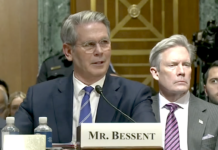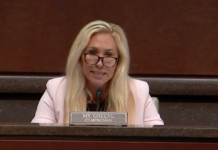
WASHINGTON (GA Recorder) — U.S. House Republicans unveiled a debt limit proposal Wednesday that would lift the nation’s borrowing capacity by $1.5 trillion or suspend it through March.
The bill, introduced by Speaker Kevin McCarthy, carries along with it numerous Republican initiatives that are unlikely to get the bipartisan support necessary to clear the divided Congress.
That ensures the legislation doesn’t have the Democratic backing necessary to move through the U.S. Senate and avoid a first-ever default on the debt as soon as mid-June.
The debt limit part of the package is somewhat different from the way Congress typically addresses extensions of borrowing authority — either suspending the debt limit through a certain date or raising the debt ceiling to a dollar figure.
Under this proposal, if the Treasury Department borrows an additional $1.5 trillion by, for example, mid-February, the debt limit would be breached at that point. But if that $1.5 trillion of borrowing authority lasts past March 31, then the debt limit suspension would expire on April 1.
The decision to introduce the GOP-only measure is the latest in a series of back-and-forth sniping between Democrats and Republicans over how to address the nation’s debt limit.
Now that House Republicans have introduced their 320-page bill, McCarthy said, President Joe Biden has “no more” excuses not to negotiate.
“President Biden has a choice — come to the table and stop playing partisan political games, or cover his ears, refuse to negotiate and risk bumbling his way into the first default in our nation’s history,” McCarthy said on the House floor, outlining the GOP bill.
Biden and Democratic leaders, however, have repeatedly called on House Republicans to release their budget resolution for the upcoming fiscal year, so they can compare that 10-year tax and spending blueprint to Biden’s budget request.
The House GOP hasn’t yet done that or given a timeline for when they will, but McCarthy said during his speech that Budget Chair Jodey Arrington of Texas would lead debate on the debt limit bill.
Biden, speaking from the International Union of Operating Engineers Local 77 in Accokeek, Maryland, rebuked Republicans for tying dozens of conservative policy positions to their debt limit bill.
“They say they’re going to default unless I agree to all these wacko notions they have,” Biden said. “Default would be worse than totally irresponsible.”
“America’s never defaulted on our debt, which has accumulated over 200 years,” Biden added.
Vote seen next week
McCarthy plans to put the bill on the House floor for a vote as soon as next week, though it wasn’t immediately clear Wednesday if it would have the votes necessary to pass that chamber. Conservative Republicans have been pushing for additional add-ons that could deter centrist GOP lawmakers from voting for the measure.
McCarthy said Wednesday from the floor the bill would:
- Set discretionary spending levels during the upcoming fiscal year to last year’s levels, leading to at least $130 billion in cuts to federal departments and agencies. That category of funding includes about one-third of the federal budget.
- Cap spending increases to 1% per year.
- “Claw back” unspent COVID-19 funding.
- Repeal the $80 billion funding boost for the Internal Revenue Service that Democrats approved last summer.
- “End green giveaways,” which includes eliminating the clean energy tax credits that Democrats approved as part of their signature climate change and health care package last summer.
- Bar the Biden administration from implementing its student loan debt forgiveness plan, which is currently awaiting a decision by the U.S. Supreme Court.
- Require that “adults without dependents, earn a paycheck, and learn new skills” in order to qualify for federal aid, though he didn’t say which programs that work requirement would apply to.
Senate passage prospects dim
If the U.S. House can send the legislation to the Senate, it’s unlikely it could gain the 60 votes needed to move past the legislative filibuster and towards final passage in the Democratically controlled chamber.
Senate Majority Leader Chuck Schumer, a New York Democrat, with input from Senate Minority Leader Mitch McConnell, a Kentucky Republican, could put together a bipartisan group of senators to negotiate a path forward for a bill that can pass the Senate.
The two could also continue waiting on Biden and McCarthy to hash out a bipartisan deal.
Biden and McCarthy met on Feb. 1 to discuss the debt limit, though the talks didn’t produce a bipartisan compromise.
McCarthy repeatedly criticized Biden during his floor speech Wednesday and on Monday after traveling to the New York Stock Exchange to press for Republicans’ approach to addressing the debt limit.
McCarthy and Republicans maintain that any debt limit legislation must include curbs on future spending, while Biden and Democrats say those negotiations should take place within the annual budget and appropriations process.
Schumer said Wednesday morning, before McCarthy released the House GOP debt limit bill, that the speaker was “still short of the support he needs to pass a debt ceiling bill, because the chasm is too big between moderates and the hard right extremists who are glad to see the economy taken hostage in exchange for their priorities.”
Schumer called on Republicans to “work with Democrats to avoid default without brinkmanship, without blackmail, without hostage-taking.”
“If Republicans drop their hostage-taking and approach Democrats in good faith, the default crisis can be resolved,” Schumer said. “But if Speaker McCarthy does not change course, he will be leading America into default of not paying our debts for the first time.”
Debt ceiling reached
The federal government reached its $31.385 trillion debt ceiling on Jan. 19.
The Treasury Department has been using accounting maneuvers known as extraordinary measures since then to keep the nation under its borrowing limit, though those moves are limited.
The federal government could exhaust those measures as soon as mid-June, though the default date could be anytime between then and September, according to estimates from the Treasury Department and the Congressional Budget Office.
If the country crosses that so-called x-date, it would be the first time in the nation’s history that it’s defaulted on its debt.
After that, the Treasury Department would be limited to spending the cash it has on hand, no longer able to borrow money in order to pay for all of the spending Congress has approved.
That would likely lead to delayed payments on all federal programs, including Social Security, Medicare, Medicaid, federal employee paychecks, public lands programs and thousands of other line items that make up the federal budget.
A default would likely lead to an economic downturn as well, possibly pushing the world into a recession depending on how long it lasts.







